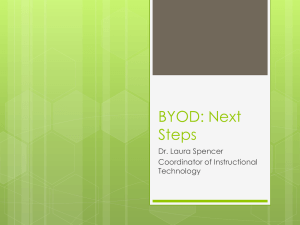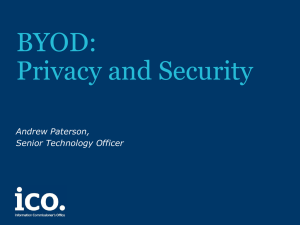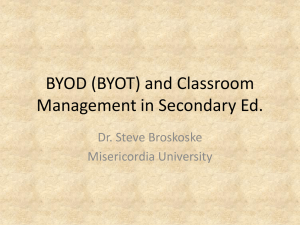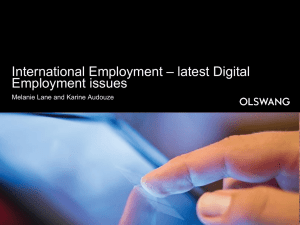Ann Tepfenhart Indirect Spend Contract Manager, Domtar Frank
advertisement
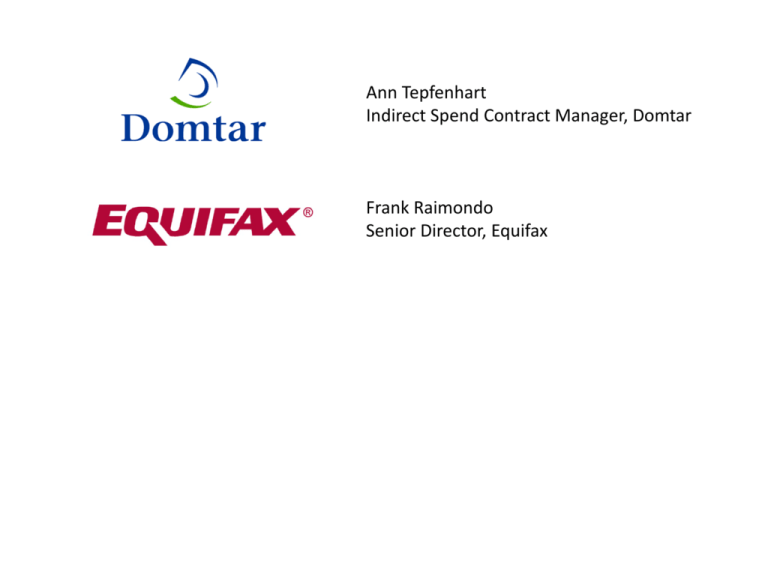
Ann Tepfenhart Indirect Spend Contract Manager, Domtar Frank Raimondo Senior Director, Equifax Cutting Mobile Device Costs Without Compromising Corporate Security • Bring Your Own Device policies are a mixed blessing: they eliminate the cost of maintaining and upgrading mobile devices, but you lose the control over managing its content and open up your network to possible security and privacy holes. This session will discuss the benefits and drawbacks of BYOD, as well as other costsaving strategies around mobile devices, such as: Working with carriers to lower replacement costs • Implementing corporate security software on employee devices Agenda • • • • Implementing BYOD Factors to Consider Other Strategies to Reduce Costs Questions & Answers Implementing BYOD A Case Study -- Domtar • Prompt was HR, not cost-driven • Device distribution before policy change: Device BlackBerry iPhone iPad Android/Other Total 876 166 128 103 • Corporate service agreements with Verizon, AT&T, Bell Mobility, Rogers and Telus Implementing BYOD A Case Study -- Domtar • Developed a task force that included Purchasing, IT and HR • We also included the service providers in implementation discussions • While the options for consumer plans and pricing differ from our negotiated corporate plans, IRU spend contributes to overall spend, which dictates our discount level for both CRU and IRU lines Implementing BYOD A Case Study -- Domtar • A new Mobile Device Plan – Plan is applicable for all Domtar divisions and companies • Two paths in the plan Mobile Device Allowance Plan A BYOD (Bring Your Own Device) Plan Preferable options for most employees Corporate Mobile Device Plan Requires VP of business unit approval Restricted usage within the company Implementing BYOD A Case Study -- Domtar • Who Remains on the Corporate Plan? Only those with VP or SVP approval, based on the following criteria: • Bargained for employees • Group (shared) phone • Frequent international travel • BYOD Monthly Allowance Four allowance levels, based job function Implementing BYOD A Case Study -- Domtar Voice Only Cell Phone Level • Employee has minimal requirements for a mobile phone for their work. • Works at a single location, but may work remotely at times. • Availability may be required outside of regular business hours. • Requires only phone and or text services . Implementing BYOD A Case Study -- Domtar Entry Level Allowance • Travels occasionally to different Domtar locations. • Works at a single location, but may work remotely at times. • Availability may be required outside of regular business hours. • Requires phone, email, data, and or text services Implementing BYOD A Case Study -- Domtar Full Level Allowance • Travels frequently to different Domtar locations and often works remotely. • Availability may be required outside of regular business hours. • Needs access to information anywhere, at any time. • Needs fast access to information and connection Implementing BYOD A Case Study -- Domtar Extensive Business Traveler • Away from their office most of the time. • Travels internationally on a frequent or regular basis. • Travels continuously to different Domtar locations, customer sites, and/or internationally. • Availability may be required outside of regular business hours. • Needs access to information anywhere, at any time. • Needs fast access to information and connection Implementing BYOD A Case Study -- Domtar • Employee lines are transitioned to IRU, as their individual contracts expire • Employee selects consumer plans and features to cover both their personal and business needs • Employee makes personal decisions involving device, insurance protection and accessories, none of which is reimbursable beyond the allowance level determined by the manager • Cost Neutral – soft savings of service plan administration has been offset by administration of T&E reimbursement Factors to Consider • BYOD may reduce equipment management costs, but the may increase administrative costs depending on how reimbursement is structured (expense reports or payroll deduction) • What effect does BYOD have on governance? Is governance possible? • What happens to an employee that goes on an overseas trip? If they bring home a bill for $10K, what happens then under BYOD? • Does BYOD truly remove devices from the cellular equation? Is the corporate infrastructure able to handle all the different types of device (BB, Android, iOS)? • What about infrastructure costs to support BYOD (e.g. AirWatch, App Whitelisting, Other MDM’s, etc.) • Is Security willing to accept the risks associated with opening “data escape vectors”? What is the nature of the data that is exposed (trade secrets? PII?) • Is performance affected by MDM technology (e.g. Using the AirWatch browser rather than Safari) • Is mobility following the same trajectory as Internet Service in the home? It used to be a benefit and now is thought of as a utility. Other Strategies to Reduce Costs • Leverage mobile spend with other telecom to gain negotiating power on services • Landline, long distance, datacom • IRU spend of employee’s personal and family lines • Negotiate directly with device manufacturers to reduce device costs





